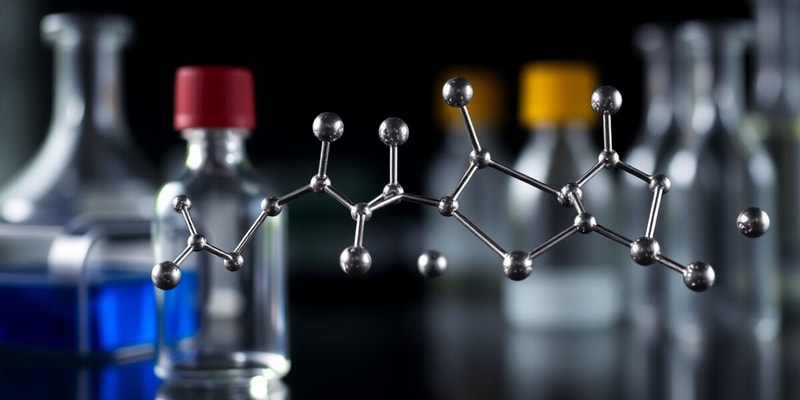Podcast
Questions and Answers
What are the two main approaches to treating diseases?
What are the two main approaches to treating diseases?
Surgical and medical approaches.
How does penicillin exemplify the impact of therapeutic drugs?
How does penicillin exemplify the impact of therapeutic drugs?
Penicillin has reduced bacterial meningitis to a treatable disease.
Define a 'drug molecule' based on the content provided.
Define a 'drug molecule' based on the content provided.
A drug molecule contains one or more functional groups arranged in a specific 3D configuration that binds to a receptor.
What is the significance of salbutamol sulfate in treating asthma?
What is the significance of salbutamol sulfate in treating asthma?
Signup and view all the answers
What are the primary characteristics that a drug molecule must possess?
What are the primary characteristics that a drug molecule must possess?
Signup and view all the answers
Describe the treatment for a myocardial infarction mentioned in the content.
Describe the treatment for a myocardial infarction mentioned in the content.
Signup and view all the answers
What advantages does the medical approach have over surgical methods?
What advantages does the medical approach have over surgical methods?
Signup and view all the answers
What role does a defined 3D structure play in a drug molecule's function?
What role does a defined 3D structure play in a drug molecule's function?
Signup and view all the answers
What is the main limitation of a rigid framework in drug design?
What is the main limitation of a rigid framework in drug design?
Signup and view all the answers
In organic chemistry, which elements are primarily studied?
In organic chemistry, which elements are primarily studied?
Signup and view all the answers
What is the molecular formula for palytoxin?
What is the molecular formula for palytoxin?
Signup and view all the answers
Differentiate between structural isomers and functional groups.
Differentiate between structural isomers and functional groups.
Signup and view all the answers
Provide an example of two structurally similar isomers.
Provide an example of two structurally similar isomers.
Signup and view all the answers
What does the term 'hydrocarbon framework' refer to in organic chemistry?
What does the term 'hydrocarbon framework' refer to in organic chemistry?
Signup and view all the answers
What is the significance of functional groups in organic molecules?
What is the significance of functional groups in organic molecules?
Signup and view all the answers
How much palytoxin is lethal for a 70 kg person?
How much palytoxin is lethal for a 70 kg person?
Signup and view all the answers
Explain the structural difference between ethanol and dimethyl ether.
Explain the structural difference between ethanol and dimethyl ether.
Signup and view all the answers
Identify the type of isomers that have the same molecular formula but different connectivity of atoms.
Identify the type of isomers that have the same molecular formula but different connectivity of atoms.
Signup and view all the answers
What is the systematic name and molecular formula for 4,4,4-Trimethyl-1-butene?
What is the systematic name and molecular formula for 4,4,4-Trimethyl-1-butene?
Signup and view all the answers
What is the name and abbreviation of a carbon chain with 5 carbon atoms?
What is the name and abbreviation of a carbon chain with 5 carbon atoms?
Signup and view all the answers
Identify the trivial name for the compound with the molecular formula C3H6O.
Identify the trivial name for the compound with the molecular formula C3H6O.
Signup and view all the answers
What are the significant molecular fragments represented by 'Ph' and 'Bn'?
What are the significant molecular fragments represented by 'Ph' and 'Bn'?
Signup and view all the answers
Explain the significance of wedges and dashes in 3D representations of molecules.
Explain the significance of wedges and dashes in 3D representations of molecules.
Signup and view all the answers
Provide the line-segment diagram notation for ethyl bromide (EtBr).
Provide the line-segment diagram notation for ethyl bromide (EtBr).
Signup and view all the answers
Identify the functional group present in the amino acid Leucine.
Identify the functional group present in the amino acid Leucine.
Signup and view all the answers
What is the systematic name and molecular formula for the compound known as 'ethyl acetate'?
What is the systematic name and molecular formula for the compound known as 'ethyl acetate'?
Signup and view all the answers
What is the prefix used for carbon rings, and what distinguishes their structure?
What is the prefix used for carbon rings, and what distinguishes their structure?
Signup and view all the answers
Name the correct abbreviation for a terminal carbon chain with 3 carbon atoms.
Name the correct abbreviation for a terminal carbon chain with 3 carbon atoms.
Signup and view all the answers
What is the difference between 'n-' and 'N-' prefixes in organic chemistry?
What is the difference between 'n-' and 'N-' prefixes in organic chemistry?
Signup and view all the answers
Differentiate between the terms 'iso-' and 'sec-' in organic nomenclature.
Differentiate between the terms 'iso-' and 'sec-' in organic nomenclature.
Signup and view all the answers
What is the chemical structure of n-Butanol?
What is the chemical structure of n-Butanol?
Signup and view all the answers
How many total hydrogen atoms are present in a decyl group?
How many total hydrogen atoms are present in a decyl group?
Signup and view all the answers
What does the abbreviation 'Bu' stand for in carbon chains?
What does the abbreviation 'Bu' stand for in carbon chains?
Signup and view all the answers
What are the two distinct conformations of cyclohexane and how do they differ?
What are the two distinct conformations of cyclohexane and how do they differ?
Signup and view all the answers
Identify the functional group in alcohols and provide its general formula.
Identify the functional group in alcohols and provide its general formula.
Signup and view all the answers
What suffix is used to denote ketones in systematic nomenclature?
What suffix is used to denote ketones in systematic nomenclature?
Signup and view all the answers
Explain how branched compounds are named systematically.
Explain how branched compounds are named systematically.
Signup and view all the answers
What is the difference in functional groups between alkenes and alkynes?
What is the difference in functional groups between alkenes and alkynes?
Signup and view all the answers
Describe the general structure of carboxylic acids.
Describe the general structure of carboxylic acids.
Signup and view all the answers
What prefix indicates the presence of one carbon atom in organic nomenclature?
What prefix indicates the presence of one carbon atom in organic nomenclature?
Signup and view all the answers
What type of compounds do alkyl halides represent and how are they generally formulated?
What type of compounds do alkyl halides represent and how are they generally formulated?
Signup and view all the answers
What is the key feature of ethers and how are they typically recognized?
What is the key feature of ethers and how are they typically recognized?
Signup and view all the answers
Define the term 'nitrile' and its common representation in organic chemistry.
Define the term 'nitrile' and its common representation in organic chemistry.
Signup and view all the answers
Study Notes
Introduction to Pharmaceutical Chemistry
- The course PF1009 - Introduction to Pharmaceutical Chemistry is taught by Dr. Tim O'Sullivan.
- The course covers various topics, including Nomenclature, Carbonyls, Carboxylic Acids, Esters, Acid Chlorides/Anhydrides, Amides, Aromatics, Epoxides, Amines.
- Lectures take place every Wednesday from 3-4 pm in LG52.
- The course utilizes three textbooks:
- Organic Chemistry – J. McMurry
- Beginning Organic Chemistry : Workbook 2 – G.L. Patrick
- (An Introduction to Medicinal Chemistry – G.L. Patrick)
- Partial notes are available on Canvas.
Treatment of Disease
- There are two primary approaches to treating disease: surgical and medical.
- Surgical approaches are labor-intensive, time-demanding, and limited to a smaller number of individuals, primarily in wealthy nations.
- Medical approaches utilize drug molecules, can treat a larger number of people, have shorter timeframes, and are employed in both developed and developing countries.
Impact of Therapeutic Drugs
- Therapeutic drugs have a significant impact, second only to public health measures in their contribution to improving health outcomes.
- Examples of drug impact:
- Penicillin transformed bacterial meningitis from a deadly disease to a treatable one.
- Salbutamol sulfate (100 µg) effectively alleviates asthma attacks.
- Lorazepam (2 mg intravenously) halts life-threatening seizures (status epilepticus).
- Morphine (8-10 mg) aids in treating myocardial infarction.
Drug Molecules
- Drug molecules consist of one or more functional groups arranged in a defined three-dimensional space on a structural framework.
- This specific arrangement allows the molecule to bind to a receptor, promoting a beneficial biological response.
- By minimizing binding to untargeted receptors, drug molecules minimize toxicity.
- A rigid framework reduces flexibility, preventing binding to secondary targets.
- Drug molecules must be stable enough to endure the journey from administration to interaction with the receptor.
Aspirin
- Aspirin is a common drug known chemically as acetylsalicylic acid.
Organic Chemistry
- Organic chemistry focuses on the study of the structures, synthesis, and reactions of carbon-containing compounds.
- It's often referred to as "the chemistry of life."
- Focus is on elements C, H, N, O, P, S, X (Halides).
Understanding Organic Structures
- Palytoxin is a potent and deadly compound.
- It takes as little as 10.5 μg to kill a 70 kg person (1 grain of sand equals roughly 2mg).
- Its chemical formula is C128H221N3O54.
Molecular, Structural, & Empirical Formulae
- Molecular formula: Shows the actual number of atoms of each element in one molecule (e.g., C6H14O2).
- Structural formula: Shows arrangement of atoms in a molecule (e.g., showing single, double, or triple bonds).
- Empirical formula: Shows the simplest whole-number ratio of atoms present in a molecule (e.g., C3H7O).
Isomers
- Isomers are compounds with the same molecular formula but different structural formulas.
- Examples of structural isomers with the formula C2H6O include ethanol and dimethyl ether.
Hydrocarbon Framework
- Hydrocarbons form the backbone of many organic compounds.
- Chains: A straight chain (e.g., n-butane) or a branched chain (e.g., isobutane).
- Rings: Cyclic structures (e.g., cyclohexane).
- Combinations: Molecules can have both chains and rings.
Functional Groups
- A Functional Group is a specific group of atoms within a molecule responsible for the molecule's chemical reactivity and properties.
- Examples include:
- Alkanes: No functional groups, denoted by the suffix '-ane'
- Alkenes: Contain a C=C double bond, denoted by the suffix '-ene'
- Alkynes: Contain a C≡C triple bond, denoted by the suffix '-yne'
- Alcohols: Contain a hydroxyl (-OH) group, denoted by the suffix '-ol'
- Ethers: Contain an alkoxy (-OR) group, denoted by the name 'X Y ether'
- Amines: Contain an amino (-NH2) group, denoted by the suffix '-amine' or 'amino-'
- Alkyl Halides: Contain a halide (-F, -Cl, -Br, -I) group, denoted by the prefix 'halo-' or '-halide'
- Aldehydes: Contain a carbonyl (C=O) group at the end of a chain, denoted by the suffix '-al'
- Ketones: Contain a carbonyl (C=O) group within a chain, denoted by the suffix '-one'
- Carboxylic acids: Contain a carboxyl (-CO2H) group, denoted by the suffix '-oic acid'
- Esters: Contain a carboxyl group with an extra alkyl (CO2R), denoted by the suffix '-ate'
- Nitriles or Cyanides: Contain a cyano or nitrile (CN) group, denoted by the prefix 'cyano-' or '-nitrile'
Systematic Nomenclature
- The IUPAC (International Union of Pure and Applied Chemistry) established a set of rules for systematically naming organic compounds.
- The suffix of the name indicates the functional group, e.g., '-ane' for alkane, '-ol' for alcohol.
- The prefix indicates the number of carbon atoms, e.g., 'meth-' (1), 'eth-' (2).
Branched Compounds
- Branched compounds are named as alkyl derivatives of the longest straight chain in the molecule.
- The length of the longest chain provides the parent name (e.g., butane).
- The straight chain is numbered from the end that produces the smaller numbers for the carbon atoms where branches occur.
- Hyphens separate numbers from names and prefixes.
- Numbers are used for functional groups that are not at a terminal carbon.
Trivial Names
- Some compounds are more commonly known by their trivial names.
- Examples:
- Acetone (propanone)
- Acetic acid (ethanoic acid)
- Ethyl ethanoate (ethyl acetate)
- Toluene (methylbenzene)
- Pyridine
- Phenol
Important Molecular Fragments
- Specific molecular fragments are important for understanding chemical reactions and structures.
- Examples:
- Phenyl (Ph): C6H5-
- Benzyl (Bn): C6H5CH2-
- PhOMe (methoxybenzene)
- BnBr (bromomethylbenzene)
- (O) (carbonyl)
- (O) (carbonyl)
Studying That Suits You
Use AI to generate personalized quizzes and flashcards to suit your learning preferences.
Related Documents
Description
This quiz covers key concepts from the PF1009 course, including nomenclature, carbonyls, and various functional groups in organic chemistry relevant to pharmaceutical applications. It aims to assess understanding of both chemical principles and their application in the treatment of diseases. Prepare to demonstrate your knowledge of medicinal chemistry and organic reactions.




